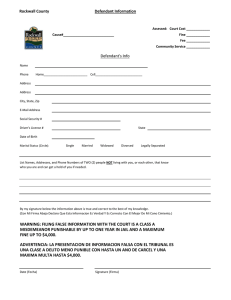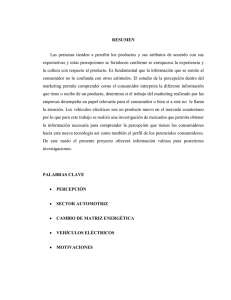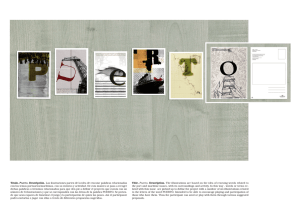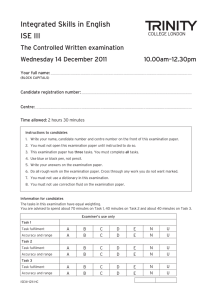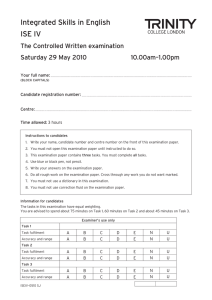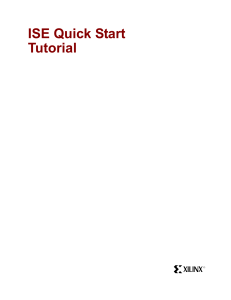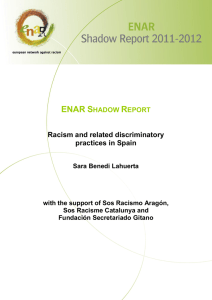Structure
Anuncio
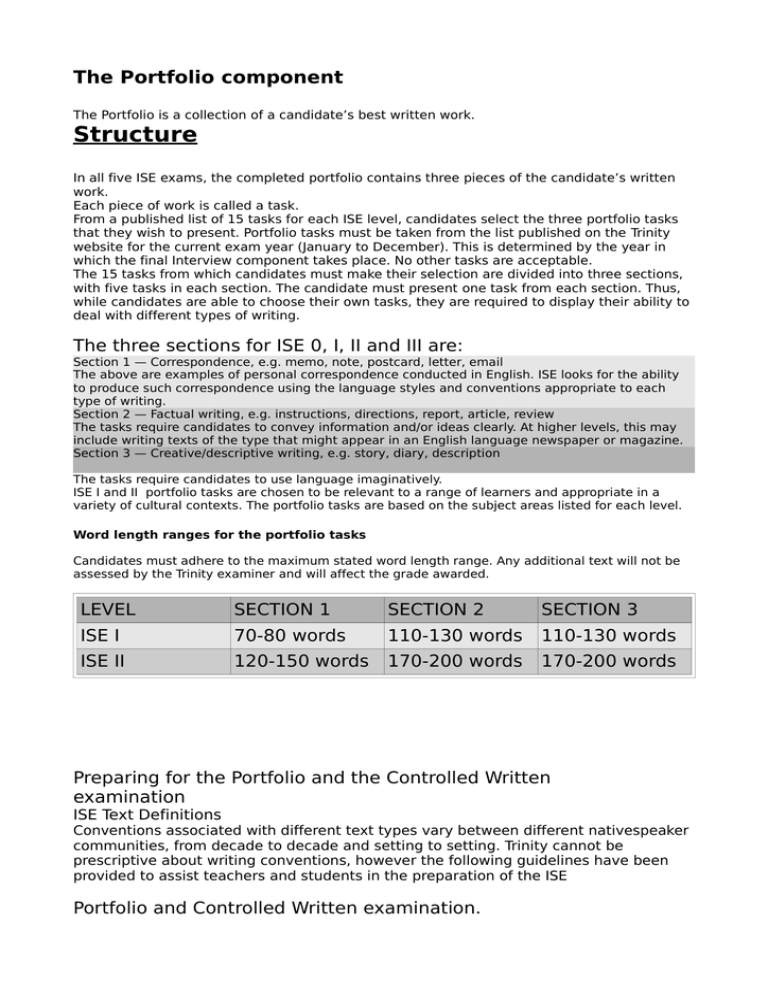
The Portfolio component The Portfolio is a collection of a candidate’s best written work. Structure In all five ISE exams, the completed portfolio contains three pieces of the candidate’s written work. Each piece of work is called a task. From a published list of 15 tasks for each ISE level, candidates select the three portfolio tasks that they wish to present. Portfolio tasks must be taken from the list published on the Trinity website for the current exam year (January to December). This is determined by the year in which the final Interview component takes place. No other tasks are acceptable. The 15 tasks from which candidates must make their selection are divided into three sections, with five tasks in each section. The candidate must present one task from each section. Thus, while candidates are able to choose their own tasks, they are required to display their ability to deal with different types of writing. The three sections for ISE 0, I, II and III are: Section 1 — Correspondence, e.g. memo, note, postcard, letter, email The above are examples of personal correspondence conducted in English. ISE looks for the ability to produce such correspondence using the language styles and conventions appropriate to each type of writing. Section 2 — Factual writing, e.g. instructions, directions, report, article, review The tasks require candidates to convey information and/or ideas clearly. At higher levels, this may include writing texts of the type that might appear in an English language newspaper or magazine. Section 3 — Creative/descriptive writing, e.g. story, diary, description The tasks require candidates to use language imaginatively. ISE I and II portfolio tasks are chosen to be relevant to a range of learners and appropriate in a variety of cultural contexts. The portfolio tasks are based on the subject areas listed for each level. Word length ranges for the portfolio tasks Candidates must adhere to the maximum stated word length range. Any additional text will not be assessed by the Trinity examiner and will affect the grade awarded. LEVEL SECTION 1 SECTION 2 SECTION 3 ISE I 70-80 words 110-130 words 110-130 words ISE II 120-150 words 170-200 words 170-200 words Preparing for the Portfolio and the Controlled Written examination ISE Text Definitions Conventions associated with different text types vary between different nativespeaker communities, from decade to decade and setting to setting. Trinity cannot be prescriptive about writing conventions, however the following guidelines have been provided to assist teachers and students in the preparation of the ISE Portfolio and Controlled Written examination. Section 1 – Correspondence D. Informal letters (All levels) Organisation and presentation • May (or may not) include the sender's address (not included in word count) • The recipient's address is not necessary and considered inappropriate for this type of letter • Date optional (not included in word count) positioned above greeting • Include an appropriate greeting e.g. ‘Dear John’ and closing e.g. ‘Best Wishes’ • The letter should be well-organised with appropriate use of paragraphs and cohesive devices • Sign off with first name only Language • Include the relevant language items of the level as required • Accurate spelling, grammar and punctuation is expected • Punctuation conventions to be observed and consistent, including address, greeting and signing-off e.g. Dear Mary(,) i.e. comma optional but not Dear Mary! • Capitalisation must be observed, as appropriate Style and register • Informal in nature e.g. contractions, abbreviations, exclamation marks • Style and register should be consistent E. Formal letters (ISE I, II, III & IV) Organisation and presentation • Include sender and recipient's address, positioned at top of letter (not included in word count) • Include date, below addresses (not included in word count) • Subject of letter (optional), positioned before greeting on left or centred • Include an appropriate greeting e.g. ‘Dear Mr Young’, ‘Dear Sir/Madam’ and closing e.g. ‘Yours faithfully’, ‘Yours sincerely’ • The letter should be well-organised into appropriate paragraphs e.g. an opening paragraph which gives the reason for writing, the body of the letter and the final concluding paragraph • Sign off with signature and full name printed underneath Language • Include the relevant language items of the level as required • Accurate spelling, grammar and punctuation is expected • Punctuation conventions to be observed and consistent, including address, greeting and signing-off e.g. Dear Mary, (comma optional) but not Dear Mary! • Capitalisation must be observed, as appropriate Style and register • Formal and more impersonal in nature e.g. relative clauses, passives, signposting words • Style and register should be consistent F. Emails (All levels) Organisation and presentation • Present in an email format. Ideally, the email should be produced on an email package (with a hardcopy printed for marking by the examiner) • Customised prompts, such as the recipient’s email address and subject line may be included and completed (not included in word count) • Include a suitable greeting and closing • The message should be brief and clear • Layout is flexible, but the text should be well-organised with appropriate use of paragraphs and cohesive devices Language • Include the relevant language items of the level as required • In real use there is great tolerance of spelling, grammar and punctuation deviations. In the context of examination submissions however, accurate spelling, grammar and punctuation is expected • Emoticons e.g. 'smilies' and conventional abbreviations e.g. ASAP are acceptable (not included in word count) • Text-messaging conventions are not acceptable, e.g. 'R', 'U’ Style and register • Choose a style and register appropriate for the audience • Style and register should be consistent Section 2 - Factual Writing C. Reports (ISE I, II, III & IV) A report is a factual description of an event or situation. It may be written for a superior (e.g. teacher, manager), a peer group (e.g. colleagues) or a general audience (e.g. a committee). A report will certainly contain some factual descriptions and explanations and possibly some suggestions, justifications or recommendations. Due to the factual nature of reports, they would not normally include the writer’s opinion. Organisation and presentation • A clear sequence is expected • Where appropriate include a heading (not included in word count) • Begin with an introduction stating the purpose of the report • The report should be clearly organised into paragraphs with section headings • May use bullet points, tables, diagrams (only written work assessed) etc. • There should be clear sign-posting, with unambiguous forward and backward referencing • Reports are usually the result of research and may contain percentages and statistics • Where appropriate end with a conclusion, which would normally be a summary of the points listed in the report Language • Use the relevant language of the level as required • Accurate spelling, grammar and punctuation is expected • Use wording and terminology appropriate to the intended audience • There is a greater tolerance of technical language as the audience for a report is likely to be restricted and to some extent informed • Cohesive devices, discourse connectors, linking expressions can be used Style and register • Content by nature is formal and therefore attracts a more formal register • Reports are more objective than articles (they should not be personal) • The style should be factual • The style and register should be consistent ¿Qué es una informe (report)? Es un escrito que da la información recopilada por su autor sobre un tema específico para, finalmente, dar una recomendación sobre qué hacer, o no hacer, en relación con el tema planteado. Qué debe contener una buen informe Es importante que el informe: Conteste a la cuestión planteada en las instrucciones. Tenga una estructura clara y bien organizada, en la cual aparezca un título, una introducción, subtítulos (headings), viñetas (para facilitar la comprensión del tema) y, acabe en la conclusión con una recomendación. El lenguaje es formal, así que evita las contracciones (aren't, wasn't, etc.) Cómo redactar un informe- How to write a report Ejemplo de pregunta: You have a part-time job at a pet shop. The manager wants to have more clients and has asked you to write a report making some recommendations. 2. Prepara un esquema utilizando frases útiles Es muy importante en el informe conectar los argumentos en un orden determinado. Te dejo ejemplos de frases que te serán útiles para este propósito. Introduction This report is intended for.../Este informe es para The objective/aim of this report is to.../El objetivo de este informe es Reporting results Some people are saying...Alguna gente dice Many people complained, suggested, recommended..../Mucha gente se quejó, sugirió, recomendó Presenting a list The following items should be taken into account/Deberían considerarse los siguientes puntos: Please, consider the following points: Por favor, considere los siguientes puntos: 1. 2. Making recommendations Therefore, I would recommend that.. En consecuencia, yo recomendaría... It would be advisable... Sería aconsejable... Redacta un esquema, teni en cuenta las instrucciones de arriba, y utilizando algunas de las siguientes frases útiles. Aquí tienes un ejemplo de esquema : Prepara el vocabulario que utilizarás Con el esquema conseguimos tener organizada la información y asegúrarnos de que estamos contestando la pregunta. Pero, tenemos que pensar en la forma de completarlo con el vocabulario y las estructuras adecuadas. Generalmente, el vocabulario estará relacionado con algunos de los temas propuestos en el currirulum del nivel. Redacta un borrador Con estas ideas en mente redactamos el borrador 5. Redacta tu informe Aquí tienes el ejemplo de informe (report) con el anterior borrador. How to get more clients for the pet shop "Meow" (1) Introduction (2) The aim of this report is to find ways to get more clients for the pet shop "Meow". I have kept a record of relevant facts that I have seen during a two-week period and I have asked some clients their opinion on the shop. What the clients say (3) The interviewed clients said the following: They did not like the veterinarian because he was sometimes rude to them. They could not find certain products for their dogs. Some products, like puppy-food, were much more expensive than in other pet shops. My observations (4) I observed that three clients left the shop without buying anything because I could not answer their questions about some of the new products. Also, there were a couple of clients who did not like our policy of not returning their money when the fish they had just bought died. Recommendations (5) In light of the above, I recommend writing and implementing some shop guidelines for all the employees. These guidelines should, at least, include the following items: Protocol with clients: How to greet them, offer information, apologise, call them when the product they want gets to the shop, etc. Shop organization: How to display the products, information about new products. Returning policies regarding fish and other animals. Prices: Compare prices with shops around the area to offer better deals. Ten cuidado con el número de palabras Análisis del informe/report (1) Title. Este escrito no es una carta, así que debes pensar en un título teniendo en cuenta las instrucciones. En este caso nos piden "Cómo incrementar el número de clientes", por tanto, ese es el título al cual he añadido un nombre ficticio para la tienda. (2) Introduction. Primero digo sobre qué va el informe y luego apunto cómo he conseguido la información para hacerlo. (3) What the clients say. Utilizo subtítulos y viñetas (también pueden ser números) para presentar la información. De esta manera, el lector puede comprender más rápidamente la información. Observa, además, como casi todos los tiempos verbales están en pasado (4) My observations. He separado con otro subtítulo, la información que yo he recopilado sobre la tienda. (5) Recommendation: Con la frase "In light of the above" (En este contexto) conecto toda la información suministrada, con mi conclusión y recomendación final. Decido nuevamente utilizar viñetas para dejar más claro al lector qué debe hacer. Aunque, esto no será siempre necesario y valdrá con una frase como "I would therefore recommend..." Revisa tu informe Este paso es MUY importante. Una revisión de lo que acabas de escribir puede evitar muchos errores. Además, procura escribir limpio y claro, evitando los tachones. D. Articles (ISE I, II, III & IV) An article is a piece of writing on a particular subject in a newspaper, magazine or journal. Articles are written to arouse interest and win over an audience who are not necessarily knowledgeable about the subject matter. It will usually include the writer’s opinion, commentary or interpretation. Organisation and presentation • Include an interesting and informative title (not included in word count), which introduces the subject and makes the reader want to read the article. • Clearly introduce the subject that will be discussed in the article • The main text should be clearly divided into paragraphs with one topic discussed in each paragraph • Conclude the article with a brief summary Language • Use the relevant language of the level as required • Accurate spelling, grammar and punctuation is expected • Cohesive devices, discourse connectors, linking expressions can be used • Descriptive language, language of opinion and rhetorical questions can also be used Style and register • The style and register will depend on the medium where the article is being reported and the intended audience • The writer must choose the most appropriate style e.g. informal, witty, serious, etc. • Style and register should be consiste At least one of the tasks will involve something intended for publication. Always read the instructions for the task carefully to be clear about whom you are writing for. What is an article? An article - is a piece of writing usually intended for publication in a newspaper, magazine or journal - is written for a wide audience, so it is essentially to attract and retain the reader's attention - may include amusing stories, reported speech and descriptions - can be formal or informal, depending on the target audience - should be written in an interesting or entertaining manner - should give opinions and thoughts, as well as facts - is in a less formal style than a report An article can - decribe an experience, event, person or place - present an opinion or balanced argumentos - compare and contrast - provide information - offer suggestions - offer advice A realistic article should consist of - an eye-catching title which attracts the reader's attention and suggests the theme of the article. (Think about why you read a magazine or newspaper article recently- what made you read it?). Articles can also have subheadings before each paragraph. - an introduction which clearly defines the topic to be covered and keeps the reader's attention. - the main body, it can be devided into different paragraphs, in which the topic is further developed in detail. - the conclusion- summarising the topic or a final opinion, recommendation or comment. REMEMBER Before you begin writing it is important to consider: - where is the article going to appear- in a newspaper or magazine? - who are the intended readers- a specific group such as student or teenagers, or adults in general? - what is the aim of the article- to advise, suggest, inform, compare and contrast, decribe, etc? These three points are the decidintg factors in the layout of your article, its style, language and level of formality. Determine the information you are going to use and organize your ideas carefully into paragraphs. Each paragraph should have a clear topic sentence. The article could be formal, semi-formal or informal, depending on your intended audience. Use vocabulary and descriptive language appropriate for the article. Linking words and expressions, and a variety of vocabulary will only improve your work and make it more interesting. DO NOT use over-personal or over-emotional language or simplistic vocabulary. DO NOT talk about yourself. You are writing for the general public, not a close circle or friends. Your opinions are only interesting to other people of you can make them amusing, justify them or explain them. E. Reviews (ISE I, II, III & IV) A review calls on the candidate to react to an event, performance, work of art or literature, film, drama, product and so on. Organisation and presentation • Include a title (not included in word count) to introduce the subject which has been reviewed • Clearly introduce the subject that will be discussed in the review • The main text should be clearly divided into paragraphs. It may contain a descriptive summary of the object under review, an evaluation of it (e.g. the weak and strong points), a comparison with other examples in the genre etc. • A final recommendation to the reader may be included Language • Use the relevant language of the level as required • Accurate spelling, grammar and punctuation is expected • Cohesive devices, discourse connectors, linking expressions can be used • Descriptive language and language of opinion can be used Style and register • The writer must choose the most appropriate style e.g. witty, serious, etc. • Style and register should be consistent F. Summary (ISE I, II, III & IV) A summary is a short clear description that gives the main facts or ideas about something. Organisation and presentation • A summary should not contain repetition or irrelevant details from the original document • It should cover every important aspect of the original document • The text should be well-organised with appropriate use of paragraphs and cohesive devices Language • Use the relevant language of the level as required • Accurate spelling, grammar and punctuation is expected Style and register • The writer must choose the most appropriate style for the intended audience • Style and register should be consistent Section 3 - Creative and descriptive writing (ISE 0, I, II & III) A. Creative writing By definition, creative writing requires originality of approach. Organisation and presentation • Layout is flexible and will vary according to the genre concerned • Include a title where appropriate (not included in word count) • The text should be well-organised with appropriate use of paragraphs and cohesive devices Language • Use the relevant language of the level as required • Accurate spelling, grammar and punctuation is expected • A variety of verb tense may be used • Descriptive language should be used to add interest e.g. adjectives and adverbs Style and register • Style and register will vary according to type of creative writing and the intended reader • Style and register should be consistent B. Descriptive writing Descriptive writing requires the writer to describe something, especially in a detailed and interesting way. Organisation and presentation • Include a title where appropriate (not included in word count) • The text should be well-organised with appropriate use of paragraphs and cohesive devices Language • Use the relevant language of the level as required • Accurate spelling, grammar and punctuation is expected • Descriptive language should be used to add interest e.g. adjectives and adverbs Style and register • Style and register will vary according to type of descriptive writing and the intended reader • Style and register should be consistent
